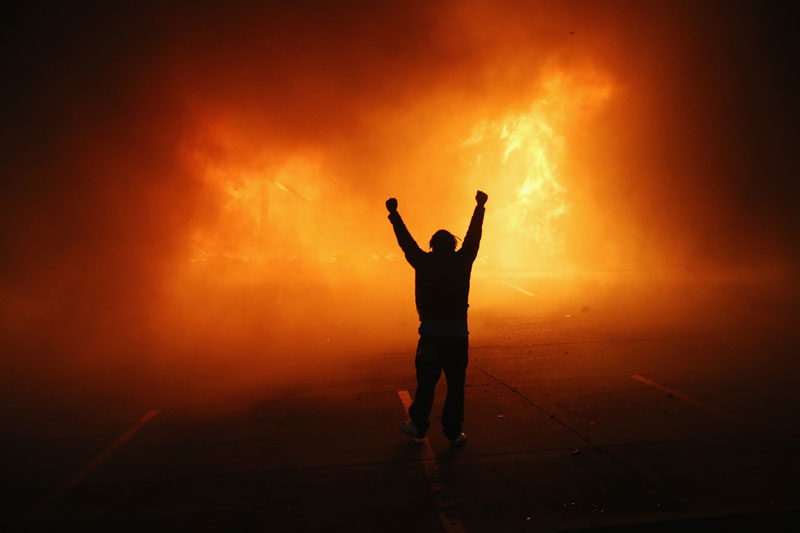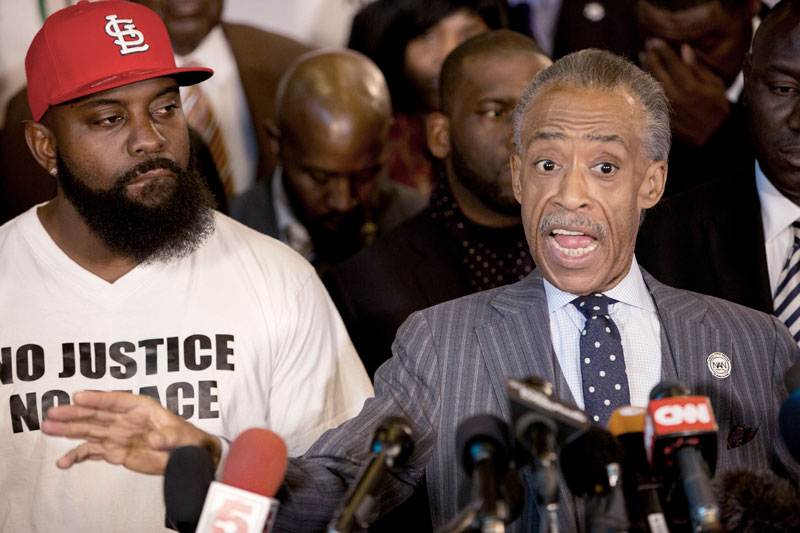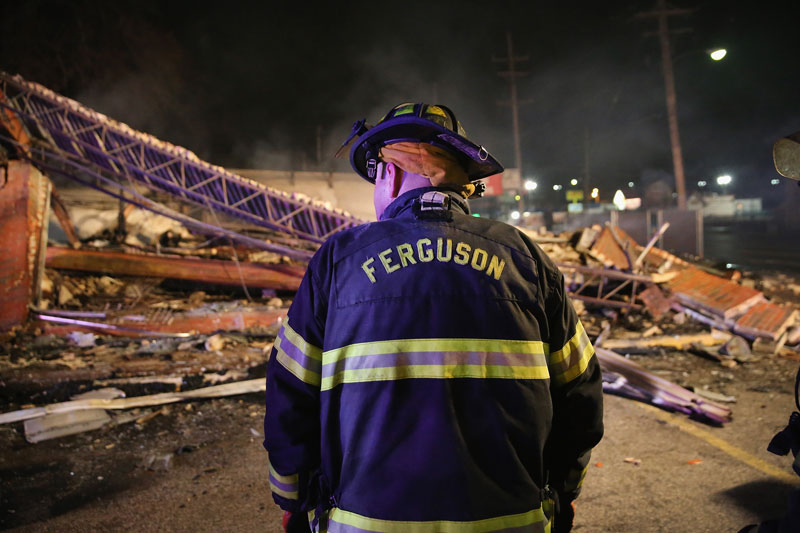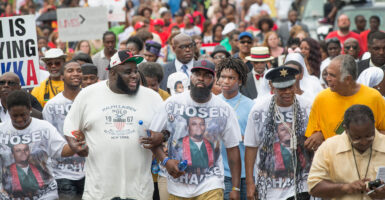Before the riots and racial strife of 2020, there was Ferguson, Missouri. On Aug. 9, 2014, an 18-year-old named Michael Brown scuffled with a police officer and was shot dead. In the days that followed, Americans watched as looting and chaos roiled the St. Louis suburb.
Now, six years later, father and son Shelby and Eli Steele have produced a compelling documentary, “What Killed Michael Brown?” The film questions the prevailing narrative of the news media, former Attorney General Eric Holder, and left-wing activists who exploited the tragedy to make it about race. There’s more to the story, according to the Steeles’ documentary.
Eli Steele, the film’s director and producer, spoke to The Daily Signal about the circumstances surrounding Brown’s death and the controversy sparked by the movie’s release. Amazon, which Steele was using to distribute the film, initially blocked it before public pressure prompted the company to reverse its decision.
The film is currently available at WhatKilledMichaelBrown.com. The following is a lightly edited transcript of our interview.
Rob Bluey: Eli, thanks so much for making this movie. I’ve had the opportunity to watch it and it is truly outstanding. Throughout the movie, we really learned a number of things that challenge the narrative that I think a lot of Americans have come to believe about Michael Brown and his death.
Can you take us back to the beginning, all the way back to 2014, and tell us what was going through your mind when Michael Brown’s death happened?
Eli Steele: First, thank you for having me. I was actually with my father at the time, and I was stuck in Monterey, California, during the fall, and Michael Brown had been shot on Aug. 9, 2014.
Like most Americans, I was just watching this unfold. At first, it looked like an awful execution, based on what was coming out of Ferguson, Missouri.
Then, as the evidence started trickling out, as we found out he was not shot in the back, he was shot in the front.
I remember studying with my father, and just saying, “Wait a minute. All this evidence is coming out.” The narrative that he was executed is still in play. Even the new evidence did not knock that narrative back.
It was the first time that we really saw a false narrative take over. Most of the time, we would be brought back into reality, we’d say, “OK, this is what really happened.” But no, this narrative just kept building. The whole notion of “Hands up, don’t shoot.”
It was happening on college campuses, institutions, everywhere. When I talk about Mike Brown to most people, they still believe in that narrative.
For me, that was a compelling reason to why I made the movie. We wanted to challenge the narrative. We wanted to explore why that happened, and why it has special power, a hold on Americans, why they wanted to believe that.

Bluey: Thank you for explaining that. The investigation you did into Michael Brown’s death brought you to Ferguson, Missouri, and to different locations across the United States.
One of the things that you and your father, Shelby Steele, explore is the question of whether racism is what killed Michael Brown, as we’ve been told. What did you find in your investigation?
Steele: It was very interesting, because the community in Ferguson remain divided over that.
Half of the people believe that he was executed, and the other half say, “No, there’s no racism.” What we did was, we used that question, “What killed Michael Brown?”
Then, my father, in about five minutes into the film, asked, “Was it really racism that killed Michael Brown?”
That, for us, was the focus of the film, because we wanted to know: Was there another reason? Was there another possibility?
In the culture that we live in today, with critical race theory, we are now told to view everything racially. If you have a disparity between two groups, it must be race. The problem, if you believe a system like that, you ignore the larger, extreme complexities.
There’s so many other reasons. There’s so many other variables, and we are going to a very simplified version.
In relation to your question, Attorney General Eric Holder came to Ferguson precisely to bring that racial narrative into play. Actually, to keep the narrative that had already come up—to keep it focused on race.
That seemed to be his main objective of going into Ferguson, because it was black boy who was shot. Why was the attorney general in Ferguson? Why not other places? Why not for other people? Why was it just for Michael Brown?
That’s a question we really explore. We go to the whole sequence with Eric Holder, and we come out of that, and we discovered that he did not go deep enough into the issue.
He should have gone into a deeper dive into what may have killed Michael Brown.

Bluey: The film portrays some of those other young black Americans who have lost their lives. It’s a very powerful and moving scene in the documentary.
I want to go back to the point about Eric Holder. As you mentioned, he came to Ferguson, Missouri. He launched his own investigation when he was attorney general at the Department of Justice.
How did he make a bad situation even worse?
Steele: He famously came into Ferguson as he said, and I’ll paraphrase, “I am the attorney general of the United States. But I am also a black man.”
When you represent an office like that, you have to represent all Americans. How is it any different than the attorney general going into Mississippi in the 1950s and basically saying, “I’m coming here as a white man.”
If he said that, every black person knows, “Whoa!” Because he’s there to represent that interest. Holder came in and the very first thing that he did was tell the mayor of Ferguson, who happens to be white, that he was not allowed to come to the meeting with all the other mayors of neighboring towns, who were black.
Why would you do that? Why would you ignore the very mayor of this town where Michael Brown was killed? Little things like that, when you do that, you poison the situation. You make it impossible for people to have good faith in the process.
Everybody is basically playing identity politics in their own little world, and they’re not coming together. Everybody knows that Eric Holder had two Department of Justice reports. The first one was by the FBI, which is independent of him, and they found there was no evidence of racism.
But when you’re in Ferguson to prove racism, what do you do? You create another report.
That report, in my opinion, had a lot of loopholes. Eric Holder basically made his whole case on this traffic stop, the ticket. I think there’s a lot of valid point to that, but I don’t think it was a deep enough of an issue.
He was trying to use that, and use the racial disparity, to prove that Ferguson was a racist town. If he could prove that Ferguson was a racist town by claiming the people who live and work in Ferguson are racist, that police officer Darren Wilson was, therefore, a racist, and Michael Brown, therefore, died because of racism.
That’s the approach that he took, and that’s a very divisive approach.

Bluey: The film brought you to St. Louis. That’s a city where your father has strong connections. You walk through the area where the Pruitt-Igoe housing project once stood. And you describe how from the 1940s to the 1960s, there was a period where black Americans were starting to really see their lives improve.
Then white liberals came along offering to lend a hand. How did this go wrong?
Steele: It’s a great story, and it’s something that I’ve always known.
My grandfather was actually born in 1900. He was 46 when my father was born. If you look at what he did, he was entrenched in segregation. He could never be more than a bus driver, even though he was probably more than qualified to be a professor at Harvard. That’s how smart he was.
He worked within the margin of freedom that he had to build a life. Many, many black people did that. The great migration started in the 1900s and onward. St. Louis was a big destination for them. They moved, just like any immigrant that comes into America. Often, they start in their own poor neighborhood, like the Lower East Side in New York, or Chinatown in San Francisco.
In St. Louis, it was North City, and they were able to eventually make money, buy their own homes. These homes were poor. They didn’t have toilets or anything like that, but these homes were low-rent opportunities.
In other words, if you saved your money, if you’re a renter, save your money, work hard, and eventually you buy a home, you could move up. That was the pattern that was happening.
It’s amazing, even one area of North St. Louis, black people actually owned more homes in the area than white people did in that area. That shows you the progress that was being made.
But you had these people, the powers that be, look at these homes as slums, as a blight on the community. Rather than upgrade these homes, put a sewer system in, make them more livable—some of them were beautiful homes—upgrade them just like we do in all of America, they destroyed all those homes.
They told the black people there, “Hey, we have these beautiful housing projects that you can live in.” When you’ve destroyed those homes, you’ve destroyed that upward movement. You’ve destroyed their home equity, everything that we needed to move upward. And you’ve put them onto a dependency track.
They may have a nice view of the river, they may have a nice view of the St. Louis Arch, but they don’t own their apartment in the housing project.

Bluey: How have white liberalism and white guilt contributed to some of the challenges that we’re facing today? Specifically, movements like Black Lives Matter have garnered support from major corporations, but appear to be fueled by concepts that are divisive, like critical race theory.
Steele: The bigger problem, as my father states in the film several times, is using race as a means to power.
In other words, race is never immune to anything. You can’t use race to arrive at truth. You can’t use race as racial progress in society, if you only use race as a means to power.
Black Lives Matter and all those other organizations are using race as a way to see what they want. The way you do that, you neglect the real problem in our society.
For example, just to give you one little example, a very contemporary example: I live in Los Angeles. My son is 12 years old. My daughter is 10. We’re part of the Los Angeles Unified School District, which is the second-largest school district in America.
In high school, which is probably about 200,000 kids in high school, you can graduate from high school with a 1.0 GPA. That is 20,000 to 25,000 people, and most of them minorities. That’s a real problem in our society, and yet we have marches through L.A., through my neighborhood, after George Floyd’s death.
It was a tragedy what happened in Minnesota. But what about the problems that we have in our own community? What about these 25,000 students that are unemployable? They really have no way of moving up, unless they wake up and realize what’s happening to them. That’s a time bomb waiting to happen.
That’s why when we use race as a means to power, we’re never really focusing on the problems that are right in front of us. We’re looking over all these problems to where they want us to look at, which is often the black man killed by a white cop.

Bluey: Initially, you had some challenges distributing “What Killed Michael Brown?” on Amazon. Can you tell us what happened?
Steele: We submitted the film to Amazon, and we were rejected from Amazon. We received a rejection letter. That was shocking because it basically said that we did not meet the level of quality.
If you look at the film, there’s nothing wrong with it. There’s nothing wrong with it technically, or anything. Obviously, I would say they rejected the film because of politics. It’s just the culture we’re living in.
This film, it’s coming like a hammer in the other way of where the corporations want you to go. They stonewalled us, but to their credit, because of Jason Riley at The Wall Street Journal and many other writers who raised an outcry over what happened, Amazon reached out to me, and basically extended an olive branch.
I took them at their word, and the film is now available on Amazon. If you go to WhatKilledMichaelBrown.com, you’ll find all the information that you need to watch the film.
Bluey: I really encourage our Daily Signal audience to take a look at it. I think that you’ll learn a lot, and become a better person as a result of watching it. Eli, thanks again. We appreciate it.
Steele: Thank you so much for having me. It means a lot.
Correction: This story has been updated with Michael Brown’s correct age.

























